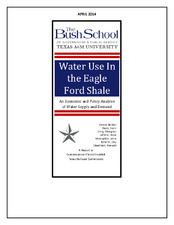| dc.description.abstract | The Eagle Ford Shale is a massive geologic formation
located in South Texas
spanning 30
Texas counties
from
Brazos County in the north east to Webb County in the southwest
. With the advent of hydraulic fracturing (HF) and
horizontal drilling, over 200 operators have been able to tap into previously inaccessible shale reserves to p
roduce
abundant amounts of oil and gas.
The oil and gas
proliferation
in the Eagle Ford
has seen
exponential growth
, and
production is not anticipated to decline until 2025. In addition,
a typical
HF
well in the Eagle Ford
is estimated to
consume
about 13
acre
-
feet
of water for
a
standard
5000
foot
lateral
.
Approximately 90% of water for HF comes
from fresh groundwater aquifers.
This interaction
of HF and
water consumption
is of primary importance from a
poli
tical
and
economic perspective. This
s
erves as t
he focal point of our
report.
Using the tools of statistics, our research considered the groundwater
consumption
trends within
the
Eagle Ford
counties
using water consumption data
of
municipal, irrigation, mining
(oil and gas)
and other
categories over a
span of four years
. This
analysis showed
that
fresh groundwater
is being consumed
at about 2.5 times
the
groundwater recharge rates
.
Furthermore,
irrigation is using more water than all other water
-
consuming
categories
combined.
Thus, the water problem
reaches well beyond the use of fresh grou
ndwater for mining
.
With respect to likely requirements of water for HF,
we posited this question:
“
W
ill technology bail us out?”
Retrofitting learning curves to our data
for water uses and
the
length of
the well
la
teral
,
we find that after i
nitial
improvements in water us
age, the technology appears to have stabilized.
This, coupled with massi
ve irrigation
water consumption
suggests
that
technology will not be a major
source of water savings
in the long run.
Instead,
we must look to better public policies
.
From a policy perspective,
the status quo for
groundwater u
se
is governed
by the
Rule of Capture and the
oversight of groundwater conservation districts
(GCDs)
. T
here exists a real conflict as large
-
scale water users are
competing for a diminishing aquifer resource with no market signals of increasing scarcity. In addition,
groundwater wells drilled
in connection with oil and gas exploration are exempt from
GCD
per
mitting
requirements
and
receive a de facto “free pass” to water for HF.
Likewise, limita
tions imposed on irrigation users
by the GCDs are rarely binding, so these users
usually
get a free pass as well.
Our analysis leads us to
three
basic
policy
recommend
ations
. The first
involves
mandatory reporting
of all
groundwater uses by all classes of water use
r
s.
Currently, government agencies and the public lack basic
information on
actual water
consumption;
t
his policy seeks to relax that knowledge gap and bring
transparency.
Second
, we propose incentivizing oil
and gas companies to substitute brackish
groundwater for fresh ground
water.
Our proposal
calls for
a severance tax reduction
for tho
se companies limiting
fresh
groundwater
use
for
HF in the
Eagle Ford.
In
addition to a temporary reduction in the
severance tax, these companies c
ould be recognized
by the
RRC and
possibly
the TCEQ for their
environmental stewardship
with a
“
Green Star
”
designation.
Our t
hird
,
most
heterodox
and long
-
term
recommendation
is to define
ground
water property rights on a per
-
acre ownership basis,
which would
attach
to the surface owner’s
real property.
Under this system, the owner
s
of the water rights would
be able to
sell
their
water as they would any other resource, and the
market would adjust the price of water to an
economically efficient level.
Most importantly, it would remove the incentive to use all you can today
, leaving
more water for the future at a lower future price. | en |


